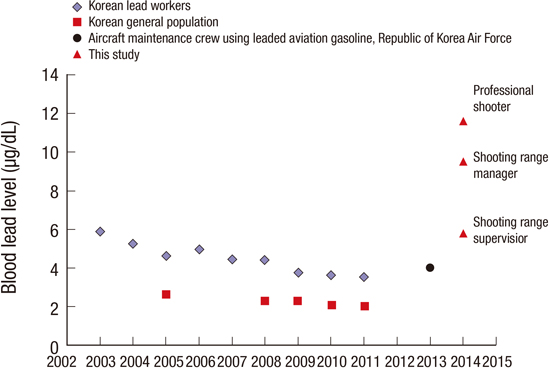1. Fischbein A, Hu H. Occupational and environmental exposure to lead. In : Rom WN, editor. Environmental and Occupational Medicine. 4th ed. Philadelphia, PA: Lippincott Williams % Wilkins;2007. p. 954–990.
2. Lewis R, Kosnett MJ. Metals. In : LaDou J, Harrison R, editors. Current Occupational and Environmental Medicine. 5th ed. New York, NY: McGraw-Hill;2014. p. 463–485.
3. Muntner P, Menke A, DeSalvo KB, Rabito FA, Batuman V. Continued decline in blood lead levels among adults in the United States: the National Health and Nutrition Examination Surveys. Arch Intern Med. 2005; 165:2155–2161.
4. Centers for Disease Control and Prevention (CDC). Blood lead levels--United States, 1999-2002. MMWR Morb Mortal Wkly Rep. 2005; 54:513–516.
5. Kim JH, Kim EA, Koh DH, Byun K, Ryu HW, Lee SG. Blood lead levels of Korean lead workers in 2003-2011. Ann Occup Environ Med. 2014; 26:30.
6. Kim H, Cho SH. Estimation of the geometric means and the reference values of blood lead levels among Koreans. J Korean Med Sci. 1994; 9:304–312.
8. Gidlow DA. Lead toxicity. Occup Med (Lond). 2015; 65:348–356.
9. Flora G, Gupta D, Tiwari A. Toxicity of lead: a review with recent updates. Interdiscip Toxicol. 2012; 5:47–58.
10. Kim NS, Lee BK. National estimates of blood lead, cadmium, and mercury levels in the Korean general adult population. Int Arch Occup Environ Health. 2011; 84:53–63.
11. Kim NH, Hyun YY, Lee KB, Chang Y, Ryu S, Oh KH, Ahn C. Environmental heavy metal exposure and chronic kidney disease in the general population. J Korean Med Sci. 2015; 30:272–277.
12. Park WJ, Gu HM, Lee SH. Blood lead level and types of aviation fuel in aircraft maintenance crew. Aviat Space Environ Med. 2013; 84:1087–1091.
13. Seo JW, Kim BG, Kim YM, Kim RB, Chung JY, Lee KM, Hong YS. Trend of blood lead, mercury, and cadmium levels in Korean population: data analysis of the Korea National Health and Nutrition Examination Survey. Environ Monit Assess. 2015; 187:146.
14. Jeong SW, Lee CK, Suh CH, Kim KH, Son BC, Kim JH, Lee JT, Lee SW, Park YB, Lee JW, et al. Blood lead concentration and related factors in Korea from the 2008 National Survey for Environmental Pollutants in the Human Body. Int J Hyg Environ Health. 2014; 217:871–877.
15. Occupational Safety and Health Administration (US). OSHA lead standards. accessed on 16 June 2015. Available at
http://www.osha.gov/SLTC/lead.
16. Koo BH, Kim YK, Lee SG, Kang DM, Kim JE. Detection of cases and a cause of lead exposure in Korean steel company. Korean J Occup Environ Med. 2012; 24:441–448.
17. Kang PK, Kim YB, Ahn IS, Lee JK, Han KS, Kim HS, Hwang KY, Lee GS, Ahn KD, Lee BK. Occupational lead exposure of storage battery industry workers in Korea. Korean J Occup Environ Med. 1998; 10:438–449.
18. Kang SK, Kim EA. Occupational diseases in Korea. J Korean Med Sci. 2010; 25:S4–12.
19. Song Y, Suh C, Kim SA, Kim N, Kim SM, Jeong SW, Kim SY, Kim KH, Kim JH, Son BC, et al. High lead exposure in two leaded bronze ingot foundry workers. Ann Occup Environ Med. 2014; 26:38.
20. Rhee KY, Choe SW. Management system of occupational diseases in Korea: statistics, report and monitoring system. J Korean Med Sci. 2010; 25:S119–S126.
21. Beaucham C, Page E, Alarcon WA, Calvert GM, Methner M, Schoonover TM; Centers for Disease Control and Prevention (CDC). Indoor firing ranges and elevated blood lead levels - United States, 2002-2013. MMWR Morb Mortal Wkly Rep. 2014; 63:347–351.
22. Centers for Disease Control and Prevention (CDC). Lead exposure from indoor firing ranges among students on shooting teams--Alaska, 2002-2004. MMWR Morb Mortal Wkly Rep. 2005; 54:577–579.
23. Svensson BG, Schütz A, Nilsson A, Skerfving S. Lead exposure in indoor firing ranges. Int Arch Occup Environ Health. 1992; 64:219–221.
24. Centers for Disease Control and Prevention (CDC). Adult blood lead epidemiology and surveillance--United States, 2008-2009. MMWR Morb Mortal Wkly Rep. 2011; 60:841–845.










 PDF
PDF ePub
ePub Citation
Citation Print
Print




 XML Download
XML Download